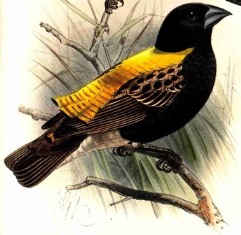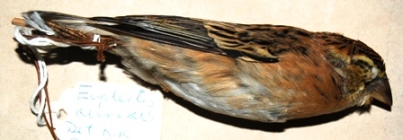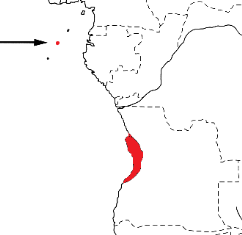Weaver Wednesday [90]: Golden-backed Bishop 2014-03-05 (490)
 Weaver Wednesday
Weaver Wednesday


The Golden-backed Bishop Euplectes aureus breeding male differs from the Yellow-crowned Bishop by a black head, from the Yellow Bishop by wholly golden orange upperparts, white wing edgings (no yellow shoulder), and a shorter tail. The female and nonbreeding male Golden-backed Bishop are distinctive with a rufous-brown breast and flanks, and the upperparts have black feathers edged rufous-brown or orange-buff.
The Golden-backed Bishop is restricted to a small area of coastal Angola, and Sao Tome Island (see map below, based on Birds of Africa). There are no subspecies of the Golden-backed Bishop.
The two isolated populations suggest that this species may have been introduced from Sao Tome to Angola, or vice versa.

The Golden-backed Bishop inhabits floodplains and rank vegetation in open acacia savanna and abandoned cotton fields, overgrown gardens with bushy cover, and tall razor-grass. In Angola it is restricted to drier lowlands below the escarpment zone.
The Golden-backed Bishop feeds on grass seeds and insects. It is generally found in small flocks, and often in mixed-species flocks.
The Golden-backed Bishop is polygynous. It is not colonial, but nests are clumped in groups of up to 10. The male defends his territory by singing from 3 to 4 song posts, but may also sing in flight over his territory. During courtship, the male fluffs out the long plumes of the back. The Golden-backed Bishop often nests alongside Black-winged Bishops, and males of the 2 species may share song posts.
The nest is oval, with a large side entrance. It is loosely woven, with a rough outer shell incorporating living grass leaf blades. A dense inner lining of fine grass seed heads protrude above the entrance, forming a distinct porch. The nest is built by the male. The nest is hidden in grass, where it is attached to vertical grass or herb stems. The eggs (clutch 2-3) are white with fine black speckles.
There are no PHOWN records for the Golden-backed Bishop yet (see PHOWN summary) - be the first to find its nest! Submit any weaver nest records to PHOWN (PHOtos of Weaver Nests) via the Virtual Museum upload site.
PHOWN summary
Previous Wedn: Weyns's Weaver
Full weaver species list
| 

 Weaver Watch
Weaver Watch


